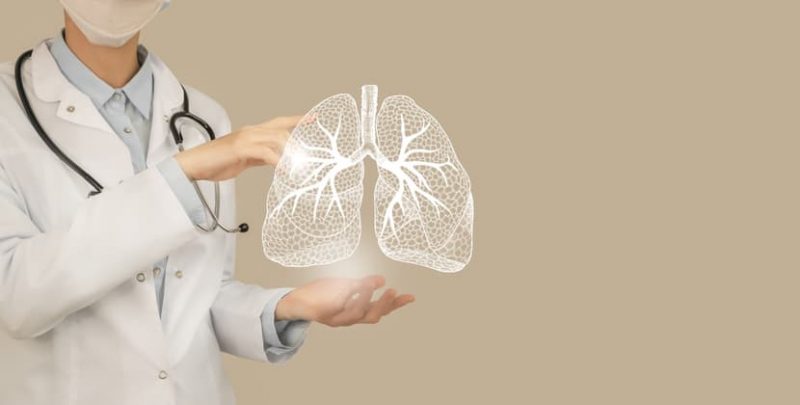Let’s be honest, on a day-to-day basis, you tend to not even think about breathing. It’s just something you do automatically without a thought. The majority of us likely don’t think about the vital role our respiratory system plays in our overall health — until something goes wrong.
Unfortunately, not ensuring that your respiratory system is in tip-top condition (yes, even before problems occur) can have a huge downside. Chronic lower respiratory diseases now rank number six on the list of leading causes of death in America, killing an estimated 46.3 out of every 100,000 people in the U.S. alone, according to the Centers for Disease Control and Prevention (CDC). Keep reading to learn more about chronic lower respiratory diseases.
What is chronic lower respiratory disease?
Considering the severity of lower respiratory diseases, let’s begin with some background. According to the World Health Organization (WHO), chronic lower respiratory disease is a classification of conditions that affect the structures of the lungs. Examples of chronic lower respiratory diseases include chronic obstructive pulmonary disease (COPD), pulmonary hypertension, asthma, and certain occupational lung diseases.
What is pulmonary hypertension?
According to the CDC, pulmonary hypertension is when the pressure in the blood vessels that travel from the heart to the lungs becomes too high. This can result in the arteries in the lungs narrowing, which causes inadequate blood flow and not enough oxygen circulating in the blood.
What is asthma?
According to the National Heart, Lung, and Blood Institute (NIH), asthma is a chronic condition that causes the tubes that carry oxygen to your lungs to become tight and swollen.
What is COPD?
Chronic obstructive pulmonary disease (COPD) is a lower respiratory disease that encompasses diseases that obstruct airflow into the lungs and cause breathing difficulties, according to the CDC. COPD often refers to the presence of two conditions occurring simultaneously — emphysema and chronic bronchitis.
What is emphysema?
According to The Mayo Clinic, emphysema is when the alveoli (the sacs in the lungs that fill with air when we breathe) become damaged. In emphysema, eventually, the alveoli will either rupture or weaken to the point that they cannot inflate anymore. This causes less surface area in the lungs for oxygen-rich air to enter, leading to old air being trapped in the lungs and not enough oxygen entering into the bloodstream.
What is chronic bronchitis?
In most cases, emphysema occurs with chronic bronchitis. Chronic bronchitis is when the bronchial tubes (the tubes that carry oxygen to the lungs) become swollen and irritated. This usually results in near-constant coughing.
What are the risk factors for chronic lower respiratory disease?
According to the WHO, chronic obstructive pulmonary disease (COPD) risk factors include:
- A genetic condition called alpha-1 antitrypsin deficiency.
- Having asthma as a child.
- Certain occupational hazards such as dust, chemicals, and other fumes.
- Indoor pollutants such as biomass fuels.
- Being born prematurely or being abnormally small in utero.
- Issues developing ideal-sized lungs during childhood.
- Tobacco smoke.
Is chronic lower respiratory disease preventable?
While not all cases of chronic lower respiratory disease are completely preventable because genetics play a role in this outcome, several lifestyle changes can reduce your risk of developing a chronic lower respiratory disease. If you do have a genetic predisposition to getting a lower respiratory disease, lifestyle changes may prevent the disease from progressing as rapidly as it would without such lifestyle changes, particularly regarding COPD.
How to prevent chronic lower respiratory disease:
A study published by the National Library of Medicine (NIH), found that the following may prevent and/or slow progression in COPD cases:
- Never smoke. If you’re already a smoker, check out resources to help you quit smoking today (see “further resources”).
- Maintain proper nutrition in your diet.
- Exercise to keep the lungs strong.
- Avoid pollutants both indoors and outdoors.
- Strive for good ventilation in the home.
- Avoid infections — primarily through vaccinations (see below).
According to the American Lung Association, in addition to the prevention strategies listed above, there are also a few other things you can do to keep your lungs healthy such as:
- Test your home for radon.
- Avoid breathing in harsh chemicals and secondhand smoke.
- Get regular check-ups so your doctor can find warning signs you may not feel physically yet.
The American Lung Association recommends avoiding infections with the following strategy:
- Getting vaccinated against the seasonal flu, every year.
- Following guidelines for COVID-19 vaccinations.
- Asking your doctor if the pneumonia vaccine is recommended for you.
- Washing your hands regularly.
- Carrying hand sanitizer for when hand washing isn’t possible.
- Staying out of crowds during cold and flu season.
Related: How Assisted Living Supports Chronic Disease Management
There are several chronic lower respiratory disease organizations committed to spreading awareness and helping people quit smoking such as The American Lung Association. There are also related organizations and initiatives for chronic lower respiratory disease such as the CDC’s How to Quit Smoking section. The best thing you can do to prevent chronic lower respiratory diseases is to quit smoking.
Chronic lower respiratory diseases are serious conditions that you should strive to avoid. By keeping yourself healthy and following doctor recommendations, you can live your best life.
Citations:
Ambrosino, N. (2018). Lifestyle interventions in prevention and comprehensive management of COPD.
Basics About COPD. (2021).
Chronic obstructive pulmonary disease (COPD). (2022).
Chronic respiratory diseases. (2022).
Emphysema. (2017).
National Vital Statistics System – Mortality Data. (2020).
Protecting Your Lungs. (2021).
Pulmonary Hypertension. (2019).
What Is Asthma?. (2022).

